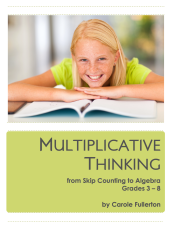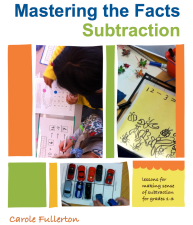Financial Literacy in Primary – Thinking About Money in the Canadian Classroom
 Hello to my friends near and far… It has been a long time since I have posted anything to my blog, and for that I am truly sorry. To my faithful visitors, I offer you my thanks. I hope this latest instalment has been worth the wait!
Hello to my friends near and far… It has been a long time since I have posted anything to my blog, and for that I am truly sorry. To my faithful visitors, I offer you my thanks. I hope this latest instalment has been worth the wait!
My newest collaboration — as always, co-created with the inimitable Sandra Ball — is entitled Financial Literacy In Primary: Thinking About Money in the Canadian Classroom. This full-colour, 50 page resource is free to download – but you’ll need a password to access it. Please use the form below to contact me for the secret code. Read on to learn more. Enjoy! Carole
Financial Literacy — An Important Aspect of Numeracy
Beginning in the fall of 2016, concepts addressing financial literacy are being introduced to the Western Canadian mathematics curriculum. Although they have been included at the middle school level for a number of years, this is the first time that financial literacy as been highlighted in elementary — and most notably at the primary level. This raises some important questions. What is financial literacy at the primary level anyway? Certainly it is more than recognizing and naming Canadian coins! Structured instead around notions of earning, saving and spending and giving money, curricular outcomes dedicated to financial literacy are intended to look more deeply at what it means to be financially responsible.
Our youngest learners need support and explicit teaching to reach these goals. Engaging, authentic and meaningful tasks are critically important. Learning about money should be fun, of course, but should include notions of social responsibility — earning, saving and giving — as well as spending!
Playing with Money: Connecting to Number Sense
 In this new resource, Sandra and I have crafted a series of lessons to support teachers in introducing and developing ideas around financial literacy in Kindergarten through Grade 3. Currently there are few — if any — resources devoted to these ideas for primary students. We are hopeful this resource will fill that need!
In this new resource, Sandra and I have crafted a series of lessons to support teachers in introducing and developing ideas around financial literacy in Kindergarten through Grade 3. Currently there are few — if any — resources devoted to these ideas for primary students. We are hopeful this resource will fill that need!
Rich tasks, literature connections and games for practice in this resource are laid out along a continuum and are intended to be used across grades. In alignment with our new curriculum, these lessons are connected to both the core competencies (Thinking, Communicating and Personal and Social Responsibility) as well as to the curricular competenciesfor mathematics. By integrating financial literacy into our math program in primary, we create meaningful contexts for the math we are learning.
Think of the mathematical expertise our students will build as we represent and describe money amounts, compare and order values, skip count with coins and bills, use place value understandings and add and subtract dollar amounts!
 The Math Big Ideas for Financial Literacy
The Math Big Ideas for Financial Literacy
This teacher resource is structured around a set of Big Math Ideas for earning money, saving money and spending and giving money. These enduring understandings apply across the primary grades and beyond. By addressing these Big Math Ideas in developmentally appropriate and engaging ways we can ensure students have fun while they lay the foundations for ensuring financially responsible decision-making.
Sandra and I hope that this resource proves useful to you and fun for your students!
To download the materials, visit my online store (https://mindfull.ecwid.com) and click on the FREE DOWNLOADS icon.
Enjoy!
Carole
Dot patterns and ten frames – Around the World for K/1/2
I thought I would post a copy of a game that I created (which I KNOW someone else out there has likely done before me!) to support young children in recognizing sets of number at a a glance. We all know how important this skill is in promoting number sense in young learners! In this game called “I have… Who Has…?” for grades 1 and 2, students start with a card (or more than one, if there are enough cards to go around!). Choose any child you like to begin the cycle. She reads from her card, from left to right, saying the number represented in the picture (“I have 14.”) and then asking the question (“Who has seven?”). Students listen for their number, then ask their question until all students have had a chance to read. The game is over when the first person to read, reads again. Be sure and hand out ALL the cards, or the cycle won’t work… 🙂

I have created a Kindergarten version of the “I have… Who has…?” game as well. The numbers go only to 10, and there are picture of fingers to help them “read” the number word. A small group – or partners – works best for this one, since there are only ten cards!
Have fun with this!
(And for my friends in Coquitlam who witnessed the spectacular initial fail of this game, rest assured that I’ve fixed it!)
Carole
Kindergarten & Grade 1 math games – mastering fives & tens
I am, as many of you know, a great fan of the games produced by the good folks at BEAM. They are conceptual, strategic and focus on the big math ideas across the grades. One of my favourites is “Totally Ten Snake”, in which two players take turns covering pairs of digits that add to 10 along a “snake” of numbers. When all the digits are covered – each player using his or her own coloured counters – the winner is the one with the longest string of digits covered in their colour. In the example below, red wins, with 4 in a row at the end of the game against purple:

Well, I love this game a lot, and when played strategically it can engage kids across the grades (and even adults at my workshops!). That said, I thought it was worth re-jigging the game for children who are younger, and for those who need support to focus on quantity rather than on the digits as set out in the original BEAM game.
These edited games are geared towards understandings of 5-ness and ten-ness, and use dots in place of digits. The rules are the same as in the original. You can download your own version of Terrific Ten Snake or the easier ten frame 10 snake and/or the Fabulous Five Worm by clicking on their names…
Enjoy! Carole

PS – If you’re looking for more ideas like this for K and grade 1, consider purchasing a copy of my book: Number Sense – A Combined Grades Resource for K, K/1 and Grade 1 Math Classrooms. It’s set up to support teachers in addressing the number PLOs in mindful ways while keeping their Kindergarten and Grade 1 students together. Games, tasks, problems and meaningful practice opportunities are included in English and in French. To order online, click here.











